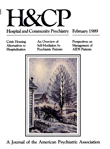Why Patients Mutilate Themselves
Abstract
Self-mutilation, the deliberate destruction or alteration of body tissue without conscious suicidal intent, occurs in a variety of psychiatric disorders. Major self-mutilation includes eye enucleation and amputation of limbs or genitals. Minor self-mutilation includes self-cutting and self-bitting. The author examines patients' explanations for self-mutilation, which frequently focus on religious or sexual themes, and discusses scientific explanations that draw on biological, psychological, social, and cultural theories. Although no one approach adequately solves the riddle of such behaviors, habitual self-mutilation may best be thought of as a purposeful, if morbid, act of self-help.
Access content
To read the fulltext, please use one of the options below to sign in or purchase access.- Personal login
- Institutional Login
- Sign in via OpenAthens
- Register for access
-
Please login/register if you wish to pair your device and check access availability.
Not a subscriber?
PsychiatryOnline subscription options offer access to the DSM-5 library, books, journals, CME, and patient resources. This all-in-one virtual library provides psychiatrists and mental health professionals with key resources for diagnosis, treatment, research, and professional development.
Need more help? PsychiatryOnline Customer Service may be reached by emailing [email protected] or by calling 800-368-5777 (in the U.S.) or 703-907-7322 (outside the U.S.).



